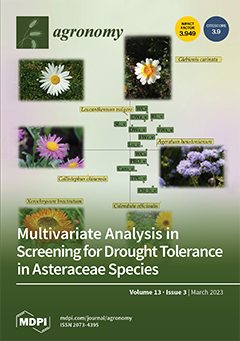Hydroponic-producing selenium (Se)-biofortified vegetables in a greenhouse is a convenient and effective way to provide Se-enriched food and overcome hidden hunger. CO
2 fertilization is commonly implemented to increase vegetable yield in greenhouse production. However, this application accompanies decreased mineral concentrations in the edible parts. Here we investigated the effects of [CO
2] and Se supply on the growth, gas exchange, and cucumber fruit quality. A hydroponic experiment with two CO
2 concentrations ([CO
2]) (C1: 410, and C2: 1200 μmol mol
−1) and four Se supply levels (Se0: 0, Se1: 0.125, Se2: 0.250, and Se3: 0.500 mg Se L
−1) was carried out. A low level of Se supply (Se1: 0.125 mg Se L
−1) protected the photosynthetic pigments and stimulated the stomatal opening, especially under [CO
2] fertilization. It leads to a higher net photosynthesis rate (Pn) and transpiration rate (Tr) than other Se treatments. The most significant changes in dry weight, fruit yield, and soluble sugar concentration were also obtained in Se1 under CO
2 fertilization due to the enhanced CO
2 fixation. Meanwhile, the Se concentration in fruit was 0.63 mg kg
−1 FW in C2Se1, with the highest Se accumulation and use efficiency. According to the recommended dietary allowance of 55 μg Se day
−1 for adults, an intake of 87 g of cucumber grown in C2Se1 is sufficient. Because of the improved Tr and better root structure in Se1, the uptake of mineral nutrients through mass flow and interception was well maintained under CO
2 fertilization. So, the concentrations of N, P, K, Ca, and Mn in cucumber fruits were not significantly decreased by elevated [CO
2] in Se1. However, the concentrations of soluble proteins, S, Mg, Fe, and Zn in cucumber fruits in C2Se1 were lower than those in C1Se1, which was mainly attributed to the dilution effects under CO
2 fertilization. Therefore, a selenite supply of 0.125 mg Se L
−1 was found to be the optimal dosage for producing Se-enriched cucumber fruits with high yield and better qualities under CO
2 fertilization (1200 μmol mol
−1).
Full article





